LOCAL THEMES
agriculture
communications
community activities
compensation
conflict
culture and customs
development
economics
education
employment and income
environment
festivals
gender
health
history
identity
industry
justice and crime
land
livestock
migration
politics
social change
social relationships
spiritual beliefs
traditional_skills
BACKGROUND
glossary
OTHER LOCATIONS
china
ethiopia
india
kenya
lesotho
mexico
nepal
pakistan
poland
|
introducing the area
 the
themes the
themes
 the
partners the
partners
 publications publications
 the
testimonies the
testimonies
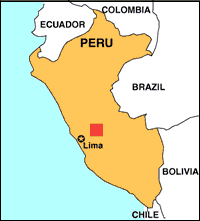 |
move cursor
over image
for local map |
The Andes mountains stretch 7,250 kms along the western margin of South America, all the way from the equator to the Antarctic; they contain the most extreme variations in landscape, vegetation and climate of any mountain group in the world. The Central Andes is characterised by large high plateaus above 3,500 m (puna or altiplano), which are the most densely populated areas of the whole range. In Peru, where this collection was gathered, 50 per cent of the population lives in the mountains; 33 per cent in the puna. Residents of these high plateaus grow frost-resistant crops, especially potatoes, and graze hardy llamas, alpacas and sheep. The Central Andes was also the heartland of the highly sophisticated, pre-Colombian indigenous empires, and several narrators in this collection speak of Inca history, surviving traditions and landmarks.
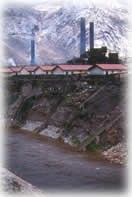 In the area around Cerro de Pasco, where this project was based, people's herding lifestyle has undergone great change, principally as a result of Peru's most important industry: mining. While it has brought employment and some infrastructure to the region, the industry paid scant regard to the environmental impact of its activities: waste from the mines seeped into the water supply, and polluted the springs which run through the pastures; lakes once famous for fish and birdlife are discoloured, empty and their surroundings silent. Fumes from the smelter and other processing plants polluted the air and have stripped the nearby slopes of vegetation. The health of people and livestock has been badly affected, animal numbers have dramatically declined and few farmers now make a living from herding alone. And as many point out, while economic necessity drove people to take jobs in the mines, the different way of life - a salary, strict timetables and a short-term focus - weakened their bond with the environment on which they previously depended. Some feel they only realised the extent of the damage when it was too late. In the area around Cerro de Pasco, where this project was based, people's herding lifestyle has undergone great change, principally as a result of Peru's most important industry: mining. While it has brought employment and some infrastructure to the region, the industry paid scant regard to the environmental impact of its activities: waste from the mines seeped into the water supply, and polluted the springs which run through the pastures; lakes once famous for fish and birdlife are discoloured, empty and their surroundings silent. Fumes from the smelter and other processing plants polluted the air and have stripped the nearby slopes of vegetation. The health of people and livestock has been badly affected, animal numbers have dramatically declined and few farmers now make a living from herding alone. And as many point out, while economic necessity drove people to take jobs in the mines, the different way of life - a salary, strict timetables and a short-term focus - weakened their bond with the environment on which they previously depended. Some feel they only realised the extent of the damage when it was too late.
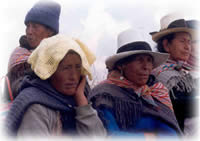 The industry is now being privatised and mechanised. Mining jobs are becoming scarcer but their legacy remains. The social, economic and environmental changes mean people cannot simply return to the old lifestyle. Changed livelihoods, lost social customs and shifts in attitude are not easily reversed. The industry is now being privatised and mechanised. Mining jobs are becoming scarcer but their legacy remains. The social, economic and environmental changes mean people cannot simply return to the old lifestyle. Changed livelihoods, lost social customs and shifts in attitude are not easily reversed.
the themes
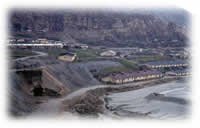 The impact of the mining industry on Cerro de Pasco and the surrounding communities underlies most narrators' stories, which were gathered in 1995. Some stress social and cultural change; others highlight the economic impact. Almost all bear witness to the environmental effects on the land, the livestock and people's health. The interviews are rich in personal detail, and the range of age, occupation and gender means a variety of views is contained in this collection. The focus on industry, and the positive and negative results of being a mineral-rich highland area, is unusual in this website, as most of the other communities lack industrial activity on any significant scale. But as resource extraction in mountain regions accelerates, these narrators' experiences will be of interest to many other communities. In Peru alone, mining activities have expanded from occupying 6 million hectares in 1992 to 24 million hectares by 2000. The impact of the mining industry on Cerro de Pasco and the surrounding communities underlies most narrators' stories, which were gathered in 1995. Some stress social and cultural change; others highlight the economic impact. Almost all bear witness to the environmental effects on the land, the livestock and people's health. The interviews are rich in personal detail, and the range of age, occupation and gender means a variety of views is contained in this collection. The focus on industry, and the positive and negative results of being a mineral-rich highland area, is unusual in this website, as most of the other communities lack industrial activity on any significant scale. But as resource extraction in mountain regions accelerates, these narrators' experiences will be of interest to many other communities. In Peru alone, mining activities have expanded from occupying 6 million hectares in 1992 to 24 million hectares by 2000.
Like other areas in the central Andes, out-migration from the region of Cerro de Pasco is a major issue. The resource base is under strain, and the younger generations' demands for education and employment mean the main trend is away from the highlands, and from rural to urban areas. Some return, but most narrators say that without better job opportunities, the majority of young people who leave to get an education will end up staying in Lima and other cities.
the partners
Cooperacción (Acción Solidaria para el Desarrollo), our Peruvian partners, were already working in the region of Cerro de Pasco. A social development organisation, they had some experience of oral history collection, but more as a cultural exercise. They approached Panos with a view to exploring how this methodology might help them learn more about the different viewpoints and experiences within the communities where they worked, as well as to generate powerful and compelling material with which to argue their case for improved environmental controls and compensation, and for measures to restore the least damaged land.
They first mounted an exhibition using extracts from the testimonies
to promote public discussion in the communities around Cerro de
Pasco. People of all ages responded and a network was created bringing
together different interest groups: miners, union members, campesino
communities, schools, students, mothers' clubs and the retired.
Cooperacción then produced an illustrated book based on the collection,
Minería y Comunidades: testimonios orales y gráficos, which has
been widely distributed and publicised. They are now supporting
a network of environmental delegates and supporting local organisations
to defend their right to "live a dignified life on the land" and
say that "the book with the testimonies has been an excellent tool
in this campaign".
publications
|
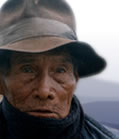
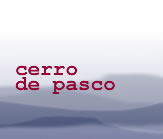


 In the area around Cerro de Pasco, where this project was based, people's herding lifestyle has undergone great change, principally as a result of Peru's most important industry: mining. While it has brought employment and some infrastructure to the region, the industry paid scant regard to the environmental impact of its activities: waste from the mines seeped into the water supply, and polluted the springs which run through the pastures; lakes once famous for fish and birdlife are discoloured, empty and their surroundings silent. Fumes from the smelter and other processing plants polluted the air and have stripped the nearby slopes of vegetation. The health of people and livestock has been badly affected, animal numbers have dramatically declined and few farmers now make a living from herding alone. And as many point out, while economic necessity drove people to take jobs in the mines, the different way of life - a salary, strict timetables and a short-term focus - weakened their bond with the environment on which they previously depended. Some feel they only realised the extent of the damage when it was too late.
In the area around Cerro de Pasco, where this project was based, people's herding lifestyle has undergone great change, principally as a result of Peru's most important industry: mining. While it has brought employment and some infrastructure to the region, the industry paid scant regard to the environmental impact of its activities: waste from the mines seeped into the water supply, and polluted the springs which run through the pastures; lakes once famous for fish and birdlife are discoloured, empty and their surroundings silent. Fumes from the smelter and other processing plants polluted the air and have stripped the nearby slopes of vegetation. The health of people and livestock has been badly affected, animal numbers have dramatically declined and few farmers now make a living from herding alone. And as many point out, while economic necessity drove people to take jobs in the mines, the different way of life - a salary, strict timetables and a short-term focus - weakened their bond with the environment on which they previously depended. Some feel they only realised the extent of the damage when it was too late. The industry is now being privatised and mechanised. Mining jobs are becoming scarcer but their legacy remains. The social, economic and environmental changes mean people cannot simply return to the old lifestyle. Changed livelihoods, lost social customs and shifts in attitude are not easily reversed.
The industry is now being privatised and mechanised. Mining jobs are becoming scarcer but their legacy remains. The social, economic and environmental changes mean people cannot simply return to the old lifestyle. Changed livelihoods, lost social customs and shifts in attitude are not easily reversed.  The impact of the mining industry on Cerro de Pasco and the surrounding communities underlies most narrators' stories, which were gathered in 1995. Some stress social and cultural change; others highlight the economic impact. Almost all bear witness to the environmental effects on the land, the livestock and people's health. The interviews are rich in personal detail, and the range of age, occupation and gender means a variety of views is contained in this collection. The focus on industry, and the positive and negative results of being a mineral-rich highland area, is unusual in this website, as most of the other communities lack industrial activity on any significant scale. But as resource extraction in mountain regions accelerates, these narrators' experiences will be of interest to many other communities. In Peru alone, mining activities have expanded from occupying 6 million hectares in 1992 to 24 million hectares by 2000.
The impact of the mining industry on Cerro de Pasco and the surrounding communities underlies most narrators' stories, which were gathered in 1995. Some stress social and cultural change; others highlight the economic impact. Almost all bear witness to the environmental effects on the land, the livestock and people's health. The interviews are rich in personal detail, and the range of age, occupation and gender means a variety of views is contained in this collection. The focus on industry, and the positive and negative results of being a mineral-rich highland area, is unusual in this website, as most of the other communities lack industrial activity on any significant scale. But as resource extraction in mountain regions accelerates, these narrators' experiences will be of interest to many other communities. In Peru alone, mining activities have expanded from occupying 6 million hectares in 1992 to 24 million hectares by 2000. 
